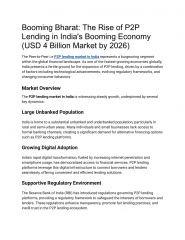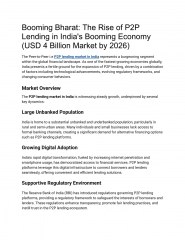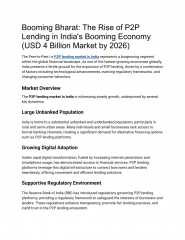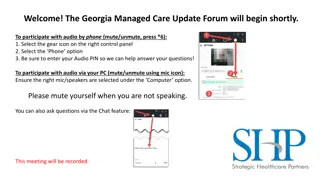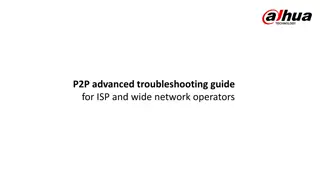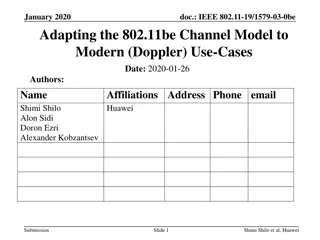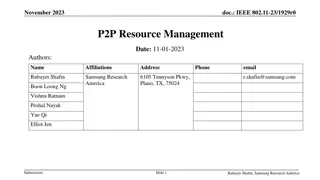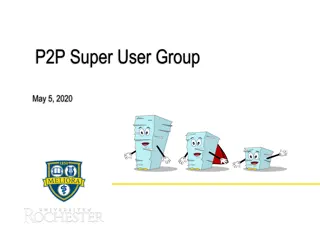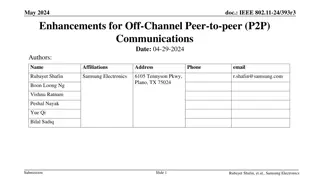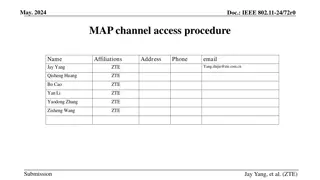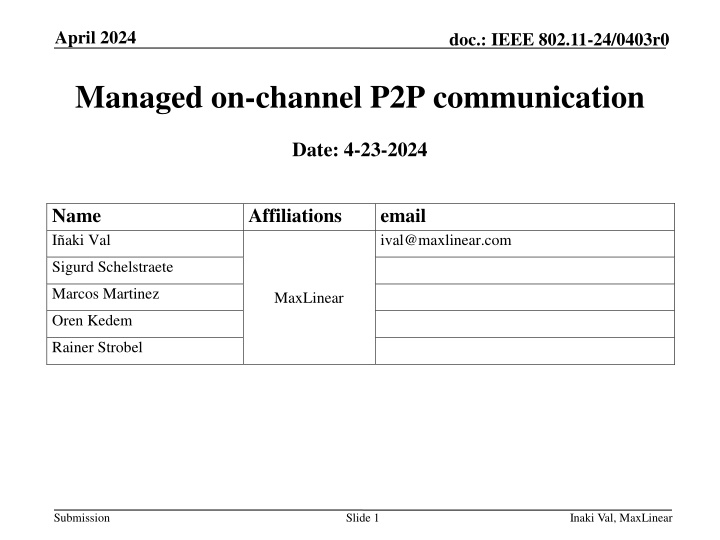
Enhancing Peer-to-Peer Communication in IEEE 802.11 Networks
Explore the proposal to enhance peer-to-peer (P2P) communication in IEEE 802.11 networks, addressing the limitations for bidirectional data exchange in latency-sensitive applications. The discussion covers the current triggered TXOP sharing mechanism, challenges in existing P2P setups, and the introduction of P2P groups for more efficient resource allocation within the network.
Download Presentation

Please find below an Image/Link to download the presentation.
The content on the website is provided AS IS for your information and personal use only. It may not be sold, licensed, or shared on other websites without obtaining consent from the author. If you encounter any issues during the download, it is possible that the publisher has removed the file from their server.
You are allowed to download the files provided on this website for personal or commercial use, subject to the condition that they are used lawfully. All files are the property of their respective owners.
The content on the website is provided AS IS for your information and personal use only. It may not be sold, licensed, or shared on other websites without obtaining consent from the author.
E N D
Presentation Transcript
April 2024 doc.: IEEE 802.11-24/0403r0 Managed on-channel P2P communication Date: 4-23-2024 Name I aki Val Affiliations email ival@maxlinear.com Sigurd Schelstraete Marcos Martinez MaxLinear Oren Kedem Rainer Strobel Submission Slide 1 Inaki Val, MaxLinear
April 2024 doc.: IEEE 802.11-24/0403r0 Introduction 802.11bn targets the improvement of packet delivery by reducing the transmission latency and enhancing network reliability [1] Applications and use cases with QoS-related requirements (e.g., bounded latency and reliability) have been growing in recent times [2] The critical QoS services can be mainly characterized by periodic traffic patterns, and strict timing requirements for data exchange [2, 3] Some of these specific applications would employ Peer-to-peer (P2P) links [4, 5], which could be beneficial in terms of latency and efficiency, offloading the AP workload Submission Slide 2 Inaki Val, MaxLinear
April 2024 doc.: IEEE 802.11-24/0403r0 P2P: Recap Peer-to-peer links allow direct communication between two non-AP STA devices, without any intervention of the AP, except for setting up the link in the case of on-channel P2P. The AP uses a triggered TXOP sharing (mode 2) mechanism to grant airtime to a non-AP STA that would send data frames to another non-AP STA. Other P2P mechanisms exist but the focus of this proposal is on extending TXOP sharing P2P mechanism Submission Slide 3 Inaki Val, MaxLinear
April 2024 doc.: IEEE 802.11-24/0403r0 Problem Statement (1/2) Some P2P target applications, such as VR/AR/XR, are based on bidirectional data exchange (closed-loop communication). Another example would be any application layer based on TCP communication. The triggered TXOP sharing (mode 2) mechanism is limited to transferring data in one direction. The granted non-AP STA1 can send data to another non-AP STA2, but the non-AP STA1 cannot receive data, as it does not support mechanisms such as trigger frames. Submission Slide 4 Inaki Val, MaxLinear
April 2024 doc.: IEEE 802.11-24/0403r0 Problem Statement (2/2) Using the existing TXS Mode 2 would require several consecutive TXOP grants, requiring the continuous action of the AP. Gained TXOP (AP) MU-RTS TXS Trigger frame MU-RTS TXS Trigger frame AP -> STA2 AP -> STA1 AP Ack CTS STA1 -> STA2 STA1 STA2 -> STA1 CTS STA2 Ack Time Time Allocated for STA1 Time Allocated for STA2 Therefore, the current TXOP sharing (mode 2) mechanism does not provide the optimal functionality to support new latency-sensitive P2P applications that would require fluid bidirectional data exchange. Submission Slide 5 Inaki Val, MaxLinear
April 2024 doc.: IEEE 802.11-24/0403r0 P2P Group P2P groups were introduced [6] to allow the AP to recognize a STA group involved within the same P2P application, and allocate resources on a per-group basis. The P2P communication could be generalized to more than two devices, but can be expected to be limited to a small number of devices (e.g., up to four devices). Not necessarily all P2P group members are associated with the AP The granted TXOP should serve the entire P2P group in any direction, as they share the same target application, and the communication is related. The P2P group members should request the resources from the AP in a previous negotiation phase. Submission Slide 6 Inaki Val, MaxLinear
April 2024 doc.: IEEE 802.11-24/0403r0 Light-weight Contention Mode The AP s granted TXOP time window could be seen as a local contention period for the P2P group, considered as a low congested scenario. The AP would grant the time to allow data exchange in any direction within the group. To this aim, we define a light-weight contention mode for EDCA, where the P2P STAs contend for the channel, assuming a low probability collision environment, as the data transmission would be driven by a common distributed application. Submission Slide 7 Inaki Val, MaxLinear
April 2024 doc.: IEEE 802.11-24/0403r0 MU-RTS TXS Trigger Frame We identify three different scenarios, and at least one STA is associated with the sharing AP: 1) All the P2P members are associated with the sharing AP 2) Some of the P2P members are in ad hoc mode 3) Some of the P2P members are associated with other AP from the same ESS Current MU-RTS TXS Trigger frame sends one User info field, we need to define a new mode that allows sending the TF to the P2P group, even if the STA is not associated (but listening in the same channel) We define the Group ID (GID) for identifying an entire P2P group, which is sent in the Trigger Frame for sharing the TXOP Replaces the AID in the User Info field The P2P STAs will join the GID in a previous negotiation phase (TBD), and the associated STA will collect the GID to request resources to the sharing AP Submission Slide 8 Inaki Val, MaxLinear
April 2024 doc.: IEEE 802.11-24/0403r0 MU-RTS TXS Trigger Frame The process for creating the P2P group and executing the data exchange is roughly described in three phases: Discovery Phase: The STAs talk each other without the intermediation of the AP (mechanism TBD), discovering the STA members of the P2P group, assigning the Group ID. Resources Request Phase: The associated STA requests to AP, the required QoS resources (e.g., SCS) for a specific Group ID and optionally awake time windows (e.g., TWT) for the STAs with PS requirements. TXOP Sharing Phase: P2P Group data exchange by sharing the AP TXOP Sharing AP Resources Request Phase P2P group (GID) TXOP Sharing P2P group (GID) TXOP Sharing P2P group (GID) TXOP Sharing STA1 P2P Group Discovery Phase (GID) STA2 Time P2P group composed of STA1 and STA2 STA1 associated with AP TWT Window Submission Slide 9 Inaki Val, MaxLinear
April 2024 doc.: IEEE 802.11-24/0403r0 Light-weight Contention TXOP RTS TXS Trigger frame Light-weight contention end Light-weight contention start SIFS Light-weight contention CTS to Self TF TA: AP RA: STA1 Sharing AP RA: GID TA: STA1 RA: STA2 TA: STA1 RA: STA2 STA1 Ack Ack CTS TA: STA2 RA: STA1 STA2 Ack Time Ack CTS Time Allocated to P2P group TWT Window After the sharing AP sends the TF to the P2P group (GID), the light-weight contention starts between the STA members, until the allocated time ends, and the AP recovers the TXOP GID is a group identifier, including non-associated STAs In case of having PS constraints, a pre-negotiated TWT window ensures the STAs are awake for receiving the starting frame Slide 10 Submission Inaki Val, MaxLinear
April 2024 doc.: IEEE 802.11-24/0403r0 Light-weight Contention TXOP RTS TXS Trigger frame SIFS Light-weight contention CTS to Self QoS Data TF CF End AP RA: GID STA1 -> STA2 STA1 -> STA2 Ack CTS STA1 P2P group STA2 - > STA1 Ack CTS Ack STA2 P2P group reset their NAV counter and start contending STA3 Time Ack Time Allocated to P2P group P2P time allocated NAV internal counter BSS NAV NAV counter of the P2P group is reset after receiving the TF, allowing the P2P group to start contending for the channel using the lightweight contention mode Other STA devices, including OBSS devices, will not change the NAV, and they will consider the channel as busy Another internal time shall count the remaining time for the allocated time Once the allocated time finishes, the P2P group restores the BSS NAV Submission Slide 11 Inaki Val, MaxLinear
April 2024 doc.: IEEE 802.11-24/0403r0 Light-weight Contention There could be several options for implementing the light contention within the P2P group contention period High-performance EDCA parameters (AISFN and CW) The Voice access category could be a good starting point to define these values. We assume that there are a very small number the devices within the contention period, whose QoS data traffic is driven by the application, and most likely there will be an order of transmission No contention with fixed IFS Assuming the application has a fixed order of data transmission, the contention could be removed, and set a fixed xIFS separation between the frames, as there will be no collisions Token-based arbitration As an additional mechanism for avoiding collisions, there could be a token-based arbitration mechanism for allowing a P2P group member to transmit. The token will be passed through the members (different strategies could be used). Submission Slide 12 Inaki Val, MaxLinear
April 2024 doc.: IEEE 802.11-24/0403r0 Summary A new Triggered TXOP sharing mode is proposed, which enables a light-weight contention period for QoS P2P group members The MU-RTS TXS Trigger frame must support a new User Info field including a Group ID, instead of AID. The P2P group STAs need to reset their NAV counter after receiving the new TF frame (RA: Group ID), and start the light contention The P2P group STAs need to maintain an internal counter of the allocated time by the AP After the allocated time expires, the P2P group STAs recover the BSS TXOP NAV counter There could be different light-weight contention options, according to application nature Submission Slide 13 Inaki Val, MaxLinear
April 2024 doc.: IEEE 802.11-24/0403r0 Conclusion We have identified the P2P communication links for some QoS time-sensitive applications, and current on- channel P2P mechanism limitations attending to the needs for bidirectional communication (closed loop) Based on the P2P group concept, we have proposed a new triggered TXOP sharing mode that would allow direct communication with the P2P group A light-weight contention mechanism is proposed to enhance the transmission efficiency and improving the end-to-end communication latency Submission Slide 14 Inaki Val, MaxLinear
April 2024 doc.: IEEE 802.11-24/0403r0 References [1] IEEE 802.11-23/0028r6, UHR PAR discussion [2] Inaki Val and et al. (MaxLinear), High Criticality Use Cases and Requirements , 23/1522r0, September 2023. [3] Oliver Holland and et al. Low Latency Communication White Paper , P802.24-23- 0010r4, July 2023. [4] Dibakar Das and et al. (Intel), TXOP sharing extensions for XR use-cases , 23/1387r1, August 2023. [5] Guoqing Li and et al. (Meta), Proxy QoS management for XR use cases , 23/1958r0, November 2023. [6] Rubayet Shafin and et al., P2P Resource Management , 23/1929r0, November 2023. Submission Slide 15 Inaki Val, MaxLinear


